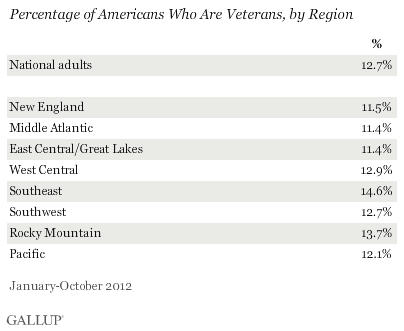PRINCETON, NJ -- On this Veterans Day 2012, about 13% of U.S. adults overall are veterans, including 24% of men and 2% of women. Veteran status among men is highly related to age, moving above the majority level for those aged 65 and older. By contrast, 12% of men aged 25 to 34 are veterans.

These data are based on more than 293,000 interviews conducted as part of Gallup Daily tracking from January through October of this year.
The impact of the military draft is evident in the trends across age groups among men. The percentage of men who have served in the military jumps from about 20% among 45- to 59-year-olds to 39% among those aged 60 to 64, and then exceeds the 50% level among men who are older. The highest percentage of veterans (80%) occurs among men now 85 to 89, who would have been just entering their late teens during World War II and its immediate aftermath. The draft effectively ended for men in the early 1970s, helping explain the rapid dropoff in veteran status among those who are now aged 55 and younger.
Veteran status is very low across all age groups of women, but, unlike the case with men, it is slightly higher among women aged 25 to 54 than it is among older women. This no doubt reflects the changing gender composition of the nation's military forces.
Veterans Fairly Evenly Distributed Across Regions of the Country
Veterans are spread out across the country in a way that is roughly proportionate to the overall adult population.

A slightly higher percentage of those living in the Southeast and in the Rocky Mountain regions report being veterans, with slightly lower percentages in New England, the Middle Atlantic, and the East Central/Great Lakes regions.
Implications
Veteran status in the U.S. is highly related to both gender and age, reflecting historical patterns relating to mandatory military service, and the continuing highly male skew of service members. The significant majority of American men aged 75 and older are veterans, compared with no more than 12% of those younger than age 35. Younger women are slightly more likely than older women to be veterans, but veteran status does not rise much above 3% in any female age group.
These demographic facts indicate that today's veteran population, estimated at about 13% overall and 24% among men, will gradually decline in the years ahead as older cohorts of men die off.
Survey Methods
Results are based on telephone interviews conducted as part of Gallup Daily tracking survey Jan. 2-Oct. 28, 2012, with a random sample of 293,309 adults, aged 18 and older, living in all 50 U.S. states and the District of Columbia.
For results based on the total sample of national adults, one can say with 95% confidence that the maximum margin of sampling error is ±1 percentage point.
Interviews are conducted with respondents on landline telephones and cellular phones, with interviews conducted in Spanish for respondents who are primarily Spanish-speaking. Each sample includes a minimum quota of 400 cellphone respondents and 600 landline respondents per 1,000 national adults, with additional minimum quotas among landline respondents by region. Landline telephone numbers are chosen at random among listed telephone numbers. Cellphone numbers are selected using random-digit-dial methods. Landline respondents are chosen at random within each household on the basis of which member had the most recent birthday.
Samples are weighted by gender, age, race, Hispanic ethnicity, education, region, adults in the household, and phone status (cellphone only/landline only/both, cellphone mostly, and having an unlisted landline number). Demographic weighting targets are based on the March 2011 Current Population Survey figures for the aged 18 and older non-institutionalized population living in U.S. telephone households. All reported margins of sampling error include the computed design effects for weighting and sample design.
In addition to sampling error, question wording and practical difficulties in conducting surveys can introduce error or bias into the findings of public opinion polls.
For more details on Gallup's polling methodology, visit www.gallup.com.
